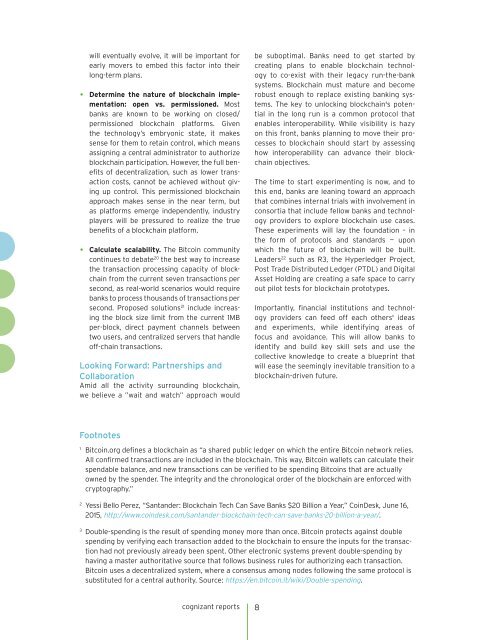• Blockchain in Banking A Measured Approach
1XwNE3Rxg
1XwNE3Rxg
Create successful ePaper yourself
Turn your PDF publications into a flip-book with our unique Google optimized e-Paper software.
will eventually evolve, it will be important for<br />
early movers to embed this factor <strong>in</strong>to their<br />
long-term plans.<br />
<strong>•</strong> Determ<strong>in</strong>e the nature of blockcha<strong>in</strong> implementation:<br />
open vs. permissioned. Most<br />
banks are known to be work<strong>in</strong>g on closed/<br />
permissioned blockcha<strong>in</strong> platforms. Given<br />
the technology’s embryonic state, it makes<br />
sense for them to reta<strong>in</strong> control, which means<br />
assign<strong>in</strong>g a central adm<strong>in</strong>istrator to authorize<br />
blockcha<strong>in</strong> participation. However, the full benefits<br />
of decentralization, such as lower transaction<br />
costs, cannot be achieved without giv<strong>in</strong>g<br />
up control. This permissioned blockcha<strong>in</strong><br />
approach makes sense <strong>in</strong> the near term, but<br />
as platforms emerge <strong>in</strong>dependently, <strong>in</strong>dustry<br />
players will be pressured to realize the true<br />
benefits of a blockcha<strong>in</strong> platform.<br />
<strong>•</strong> Calculate scalability. The Bitco<strong>in</strong> community<br />
cont<strong>in</strong>ues to debate 20 the best way to <strong>in</strong>crease<br />
the transaction process<strong>in</strong>g capacity of blockcha<strong>in</strong><br />
from the current seven transactions per<br />
second, as real-world scenarios would require<br />
banks to process thousands of transactions per<br />
second. Proposed solutions 21 <strong>in</strong>clude <strong>in</strong>creas<strong>in</strong>g<br />
the block size limit from the current 1MB<br />
per-block, direct payment channels between<br />
two users, and centralized servers that handle<br />
off-cha<strong>in</strong> transactions.<br />
Look<strong>in</strong>g Forward: Partnerships and<br />
Collaboration<br />
Amid all the activity surround<strong>in</strong>g blockcha<strong>in</strong>,<br />
we believe a ”wait and watch” approach would<br />
be suboptimal. Banks need to get started by<br />
creat<strong>in</strong>g plans to enable blockcha<strong>in</strong> technology<br />
to co-exist with their legacy run-the-bank<br />
systems. <strong>Blockcha<strong>in</strong></strong> must mature and become<br />
robust enough to replace exist<strong>in</strong>g bank<strong>in</strong>g systems.<br />
The key to unlock<strong>in</strong>g blockcha<strong>in</strong>'s potential<br />
<strong>in</strong> the long run is a common protocol that<br />
enables <strong>in</strong>teroperability. While visibility is hazy<br />
on this front, banks plann<strong>in</strong>g to move their processes<br />
to blockcha<strong>in</strong> should start by assess<strong>in</strong>g<br />
how <strong>in</strong>teroperability can advance their blockcha<strong>in</strong><br />
objectives.<br />
The time to start experiment<strong>in</strong>g is now, and to<br />
this end, banks are lean<strong>in</strong>g toward an approach<br />
that comb<strong>in</strong>es <strong>in</strong>ternal trials with <strong>in</strong>volvement <strong>in</strong><br />
consortia that <strong>in</strong>clude fellow banks and technology<br />
providers to explore blockcha<strong>in</strong> use cases.<br />
These experiments will lay the foundation – <strong>in</strong><br />
the form of protocols and standards — upon<br />
which the future of blockcha<strong>in</strong> will be built.<br />
Leaders 22 such as R3, the Hyperledger Project,<br />
Post Trade Distributed Ledger (PTDL) and Digital<br />
Asset Hold<strong>in</strong>g are creat<strong>in</strong>g a safe space to carry<br />
out pilot tests for blockcha<strong>in</strong> prototypes.<br />
Importantly, f<strong>in</strong>ancial <strong>in</strong>stitutions and technology<br />
providers can feed off each others' ideas<br />
and experiments, while identify<strong>in</strong>g areas of<br />
focus and avoidance. This will allow banks to<br />
identify and build key skill sets and use the<br />
collective knowledge to create a bluepr<strong>in</strong>t that<br />
will ease the seem<strong>in</strong>gly <strong>in</strong>evitable transition to a<br />
blockcha<strong>in</strong>-driven future.<br />
Footnotes<br />
1<br />
Bitco<strong>in</strong>.org def<strong>in</strong>es a blockcha<strong>in</strong> as “a shared public ledger on which the entire Bitco<strong>in</strong> network relies.<br />
All confirmed transactions are <strong>in</strong>cluded <strong>in</strong> the blockcha<strong>in</strong>. This way, Bitco<strong>in</strong> wallets can calculate their<br />
spendable balance, and new transactions can be verified to be spend<strong>in</strong>g Bitco<strong>in</strong>s that are actually<br />
owned by the spender. The <strong>in</strong>tegrity and the chronological order of the blockcha<strong>in</strong> are enforced with<br />
cryptography.”<br />
2<br />
Yessi Bello Perez, “Santander: <strong>Blockcha<strong>in</strong></strong> Tech Can Save Banks $20 Billion a Year,” Co<strong>in</strong>Desk, June 16,<br />
2015, http://www.co<strong>in</strong>desk.com/santander-blockcha<strong>in</strong>-tech-can-save-banks-20-billion-a-year/.<br />
3<br />
Double-spend<strong>in</strong>g is the result of spend<strong>in</strong>g money more than once. Bitco<strong>in</strong> protects aga<strong>in</strong>st double<br />
spend<strong>in</strong>g by verify<strong>in</strong>g each transaction added to the blockcha<strong>in</strong> to ensure the <strong>in</strong>puts for the transaction<br />
had not previously already been spent. Other electronic systems prevent double-spend<strong>in</strong>g by<br />
hav<strong>in</strong>g a master authoritative source that follows bus<strong>in</strong>ess rules for authoriz<strong>in</strong>g each transaction.<br />
Bitco<strong>in</strong> uses a decentralized system, where a consensus among nodes follow<strong>in</strong>g the same protocol is<br />
substituted for a central authority. Source: https://en.bitco<strong>in</strong>.it/wiki/Double-spend<strong>in</strong>g.<br />
cognizant reports 8









